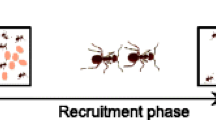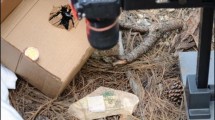Abstract
This study investigates individual flexibility of foraging ants (Pheidole dentata) when the number of nestmates is altered by establishing broodless and queenless colony fragments all originating from a single big colony. Scouts from small groups (5 to 15 ants) behave like solitary foragers. They feed for long periods of time, they return slowly into the nest, and they recruit weakly. The ingested food is distributed by trophallaxis. Scouts from larger (20- to 30-ant) fragments forage more socially. Feeding and return times are short and recruitment is strong. Later the food is always transported into the nest. Two alternative mechanisms are discussed to explain the differences in individual foraging behavior. For the first—individual flexibility—assumptions have to be made about the capabilities of the individual, its work repertoire, and decision making outside the nest. The second mechanism takes into account that ants are capable of perceiving CO 2 concentration differences and that ant groups are more active at higher CO 2 concentrations. The organizational differences at the group level are explained simply by tempo differences in individual ants without making assumptions about individual capabilities.
Similar content being viewed by others
REFERENCES
Bernstein, R. A. (1975). Foraging strategies of ants in response to variable food density. Ecology 56: 213-219.
Bhatkar, A., and Whitcomp, W. H. (1970). Artificial diet for rearing various species of ants. Fla. Entomol. 53: 229-232.
Bonabeau, E., Theraulaz, G., Deneubourg, J.-L., Aron, S., and Camacine, S. (1997). Self organization in social insects. TREE 12: 188-193.
Bourke, A. F. G., and Franks, N. R. (1995). Social Evolution in Ants, Princeton University Press, Princeton, NJ.
Burkhardt, J. F. (1991a). Koloniegröße und deren Darstellung als Signal in Ameisenkolonien: Einfluß auf Aktivität und Futtersuche, Dissertation, Universität Tübingen, Tübingen.
Burkhardt, J. F. (1991b). Der Einfluß verschiedener CO2-Konzentrationen auf das Verhalten der Ameise Pheidole pallidula. Verh. dt. Zool. Ges. 84: 303-304.
Calabi, P. (1988). Behavioral flexibility in Hymenoptera: A re-examination of the concept of caste. In Trager, J. C. (ed.), Advances in Myrmecology, E. J. Brill, Leiden.
Davidson, D. (1977). Foraging ecology and community organization in desert seed-eating ants. Ecology 58: 725-737.
Detrain, C., and Pasteels, J. M. (1992). Caste polyethism and collective defense in the ant, Pheidole pallidula: The outcome of quantitative differences in recruitment. Behav. Ecol. Sociobiol. 29: 405-412.
Ehrhardt, S. (1931). Über die Arbeitsteilung bei Myrmica-und Messor-Arten. Z. Morph. Ökol. Tiere 20: 755-812.
Franks, N. R., and Tofts, C. (1994). Foraging for work: How tasks allocate workers. Anim. Behav. 48: 470-472.
Fewell, J. H., Ydenberg, R. C., and Winston, M. L. (1991). Individual foraging effort as a function of colony population in the honey bee Apis mellifera L. Anim. Behav. 42: 153-155.
Gordon, D. M. (1991). Behavioral flexibility and the foraging ecology of seed-eating ants. Am. Nat. 138: 379-411.
Gordon, D. M. (1992). How colony growth affects forager intrusion in neighboring harvester ant colonies. Behav. Ecol. Sociobiol. 31: 417-427.
Gordon, D. M., Paul, R. E. H., and Thorpe, K. (1993). What is the function of encounter patterns in ant colonies? Anim. Behav. 45: 1083-1100.
Gregg, R. E. (1942). The origin of castes in ants with special reference to Pheidole morrisi Forel. Ecology 233: 295-308.
Hangartner, W. (1969). Structure and variability of the individual odor trail in Solenopsis geminata Fabr. (Hym., Formicidae). Z. Vergl. Physiol. 62: 111-120.
Herbers, J. M. (1982). Queen number and colony ergonomics in Leptothorax longispinosus. In Breed, M. D., Michener, C. D., and Evans, H. E. (eds.), The Biology of Social Insects, Westview Press, Boulder, CO, pp. 238-242.
Herbers, J. M. (1983). Social organization in Leptothorax ants: Within-and between-species patterns. Psyche 85: 361-386.
Herbers, J. M., and Choiniere, E. (1996). Foraging behaviour and colony structure in ants. Anim. Behav. 51: 141-153.
Hölldobler, B., and Möglich, M. (1980). The foraging system of Pheidole militicida (Hymenoptera: Formicidae). Insectes Soc. 27(3): 237-264.
Hölldobler, B., and Wilson, E. O. (1990). The Ants, Springer, Berlin, Heidelberg.
Hurlbert, S. H. (1984). Pseudoreplication and the design of field experiments. Ecol. Monogr. 54: 187-211.
Kleineidam, C., and Tautz, J. (1996). Perception of carbon dioxide and other “air-condition” parameters in the leaf cutting ant Atta cephalotes. Naturwissenschaften 83: 566-568.
Lechner, M. (1995). Aktivität, Futtersuchstrategien und Orientierung von Ameisenkolonien der Art Lasius niger unter Einfluß von Kohlendioxid, Staatsexamensarbeit, Universität Tübingen, Tübingen.
Leonard, J. G., and Herbers, J. M. (1986). Foraging tempo in two woodland ant species. Anim. Behav. 34: 1172-1181.
Oster, G., and Wilson, E. O. (1978). Caste and Ecology in the Social Insects, Princeton University Press, Princeton, NJ.
Robinson, G. E., and Page, R. E., Jr. (1988). Genetic determination of guarding and undertaking in honey-bee colonies. Nature 333: 356-358.
Robinson, G. E., and Page, R. E., Jr., and Huang, Z.-Y. (1994). Temporal polyethism in social insects is a developmental process. Anim. Behav. 48: 467-469.
SAS Institute Inc. (1987). SAS/STAT Guide for Personal Computers, Version 6 Edition, SAS Institute Inc., Cary, NC.
Schneirla, T. C. (1971). Army Ants: A Study in Social Organization, Freeman, San Francisco.
Sorensen, A. A., Bush, T. M., and Vinson, S. B. (1984). Behavioral flexibility of temporal subcastes in the fire ant, Solenopsis invicta in response to food. Psyche 91: 319-331.
Sudd, J. H. (1960). The foraging method of Pharao's ant, Monomorium pharaonis (L.) Anim. Behav. 8: 67-76.
Szlep-Fessel, R. (1970). The regulatory mechanism in mass foraging and recruitment of soldiers in Pheidole. Insectes Soc. 17: 233-244.
Tofts, C., and Franks, N. R. (1992). Doing the right thing: ants, honeybees and naked mole-rats. TREE 7: 346-349.
Tsuji, K. (1990). Reproductive division of labour related to age in the Japanese queenless ant, Pristomyrmex pungens. Anim. Behav. 39: 843-849.
Vowles, D. M. (1955). The foraging of ants. Anim. Behav. 3: 1-13.
Wallis, D. I. (1962). The relation between hunger, activity and worker function in an ant colony. Proc. Zool. Soc. London 139: 589-605.
Wilson, E. O. (1975). Enemy specification in the alarm-recruitment system of an ant. Science 190: 789-800.
Wilson, E. O. (1976a). The organization of colony defense in the ant Pheidole dentata Mayr (Hym. Formicidae). Behav. Ecol. Sociobiol. 1: 63-81.
Wilson, E. O. (1976b). Behavioral discretization and the number of castes in an ant species. Behav. Ecol. Sociobiol. 1: 141-154.
Wilson, E. O. (1980). Caste and division of labor in leaf-cutter ants (Hymenoptera: Formicidae: Atta). II. The ergonomic optimization of leaf cutting. Behav. Ecol. Sociobiol. 7: 157-165.
Wilson, E. O. (1983). Caste and division of labor in leaf-cutter ants (Hymenoptera: Formicidae: Atta). III. Ergonomic resiliency in foraging by A. cephalotes. Behav. Ecol. Sociobiol. 14: 47-54.
Wilson, E. O. (1984). The relation between caste ratios and division of labor in the ant genus Pheidole (Hym. Form). Behav. Ecol. Sociobiol. 16: 89-98.
Author information
Authors and Affiliations
Rights and permissions
About this article
Cite this article
Burkhardt, J.F. Individual Flexibility and Tempo in the Ant, Pheidole dentata, the Influence of Group Size. Journal of Insect Behavior 11, 493–505 (1998). https://doi.org/10.1023/A:1022311312607
Issue Date:
DOI: https://doi.org/10.1023/A:1022311312607




